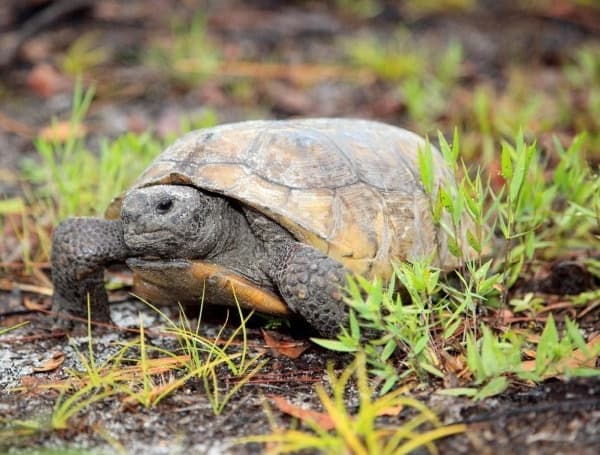Two conservation groups Wednesday filed a lawsuit challenging a decision by federal wildlife officials to reject listing gopher tortoises as endangered or threatened species, saying the burrowing animals face a “grim” future without help.
The Center for Biological Diversity and Nokuse Education, Inc., filed the lawsuit in federal court in Jacksonville after the U.S. Fish and Wildlife Service in October said increased protections were not warranted for gopher tortoises in Florida, Georgia, South Carolina and parts of Alabama.
The lawsuit pointed to issues such as development encroaching on gopher-tortoise habitats and said the federal agency’s decision last year was “contrary to the best available science.”
In the news: Florida Man Arrested After Stolen Galapagos Tortoise Found In His Freezer
“The gopher tortoise’s decline is driven primarily by habitat destruction, degradation and fragmentation, which leaves the species fewer places to live,” the lawsuit said. “These threats are ongoing and likely to continue into the future, meaning the tortoise’s outlook is likely to worsen.”
The groups want a judge to vacate the U.S. Fish and Wildlife Service’s October decision and require the agency to undertake a process that will lead to a new “finding.” The lawsuit alleges that federal wildlife officials violated the Endangered Species Act and a law known as the Administrative Procedure Act in determining that added protections were not warranted.
In a 113-page decision, the agency concluded that gopher tortoises in Florida, Georgia, South Carolina and parts of Alabama were “not in danger of extinction.”
“Although the threats to the species of habitat loss and fragmentation due to urbanization, climate change, sea level rise, and habitat management are expected to persist in the foreseeable future and the effects of these threats on this long-lived species will continue at some level, some threats have been reduced and will continue to be reduced through implemented and ongoing conservation actions and regulatory mechanisms,” the October decision said.
Federal wildlife officials kept a longstanding threatened-species listing for gopher tortoises in parts of southwest Alabama, Mississippi and Louisiana.
Gopher tortoises have spurred debates in Florida for years, as development has spread and conservationists have pushed for habitat protections. Gopher tortoises are considered threatened by the state, which has a permitting process for capturing and relocating the animals.
In the news: Feds Deny Increased Gopher Tortoise Protections In Florida
The Legislature last year passed a measure that took steps to increase the sites where gopher tortoises could be moved. In part, the bill directed state agencies to consider using parts of certain public lands as gopher tortoise “recipient” sites. Also, it called for the Florida Fish and Wildlife Conservation Commission to “streamline and improve the review of applications for public and private gopher tortoise recipient sites.”
In the lawsuit filed Wednesday, attorneys for the Center for Biological Diversity and Nokuse Education wrote that “existing regulatory mechanisms are not adequate” to prevent threats to gopher tortoises.
“Urban development of tortoise habitat is particularly harmful because it drives and increases many other threats to the species,” the lawsuit said. “In addition to directly destroying habitat, development can kill or injure individual tortoises; disrupt habitat connectivity (habitat fragmentation), which reduces immigration between populations and can negatively affect population genetics; and impede habitat management activities like prescribed fire. Development also leads to increased human-driven threats like road deaths, nonnative species invasions and persecution by people, pets, and other predators.”
Android Users, Click To Download The Free Press App And Never Miss A Story. Follow Us On Facebook and Twitter. Signup for our free newsletter.
We can’t do this without your help; visit our GiveSendGo page and donate any dollar amount; every penny helps

